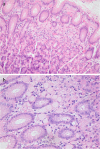Familial gastric cancer: detection of a hereditary cause helps to understand its etiology
- PMID: 23231819
- PMCID: PMC3547820
- DOI: 10.1186/1897-4287-10-18
Familial gastric cancer: detection of a hereditary cause helps to understand its etiology
Abstract
Worldwide, gastric cancer is one of the most common forms of cancer, with a high morbidity and mortality. Several environmental factors predispose to the development of gastric cancer, such as Helicobacter pylori infection, diet and smoking. Familial clustering of gastric cancer is seen in 10% of cases, and approximately 3% of gastric cancer cases arise in the setting of hereditary diffuse gastric cancer (HDGC). In families with HDGC, gastric cancer presents at relatively young age. Germline mutations in the CDH1 gene are the major cause of HDGC and are identified in approximately 25-50% of families which fulfill strict criteria. Prophylactic gastrectomy is the only option to prevent gastric cancer in individuals with a CDH1 mutation. However, in the majority of families with multiple cases of gastric cancer no germline genetic abnormality can be identified and therefore preventive measures are not available, except for general lifestyle advice. Future research should focus on identifying new genetic predisposing factors for all types of familial gastric cancer.
Figures

References
-
- Curado MP, Edwards B, Shin HR, Storm H, Ferlay J, Heanue M, Boyle P. Cancer incidence in Five Continents. Lyon, France: IARC Scientific publication; 2007.
-
- Bosman FT, Carneiro F, Hruban RH, Theise ND. WHO Classification of Tumours of the Digestive System. 4. Lyon, France: IARC; 2010.
-
- Lauren P. The two histological main types of gastric carcinoma: diffuse and so-called intestinal-type carcinoma. An attempt at a histo-clinical classification. Acta Pathol Microbiol Scand. 1965;64:31–49. - PubMed
LinkOut - more resources
Full Text Sources
Miscellaneous

